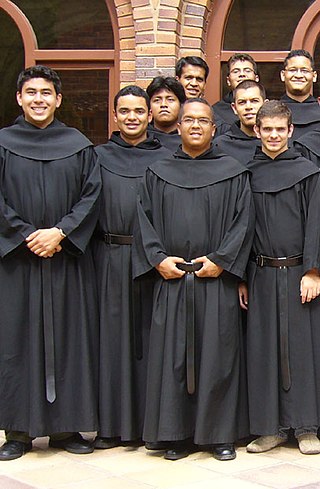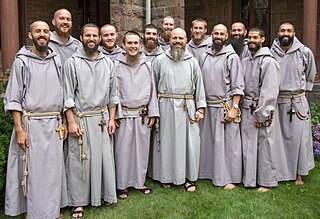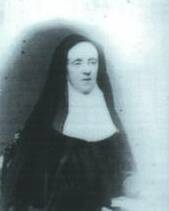
The Franciscans are a group of related mendicant religious orders of the Catholic Church. Founded in 1209 by the Italian saint Francis of Assisi, these orders include three independent orders for men, orders for nuns such as the Order of Saint Clare, and the Third Order of Saint Francis open to male and female members. They adhere to the teachings and spiritual disciplines of the founder and of his main associates and followers, such as Clare of Assisi, Anthony of Padua, and Elizabeth of Hungary. Several smaller Protestant Franciscan orders or other groups have been established since late 1800s as well, particularly in the Anglican and Lutheran traditions.

Maximilian Kolbe was a Polish Catholic priest and Conventual Franciscan friar who volunteered to die in place of a man named Franciszek Gajowniczek in the German death camp of Auschwitz, located in German-occupied Poland during World War II. He had been active in promoting the veneration of the Immaculate Virgin Mary, founding and supervising the monastery of Niepokalanów near Warsaw, operating an amateur-radio station (SP3RN), and founding or running several other organizations and publications.

A friar is a member of one of the mendicant orders in the Roman Catholic Church. There are also friars outside of the Roman Catholic Church, such as within the Anglican Communion. The term, first used in the 12th or 13th century, distinguishes the mendicants' itinerant apostolic character, exercised broadly under the jurisdiction of a superior general, from the older monastic orders' allegiance to a single monastery formalized by their vow of stability. A friar may be in holy orders or be a non-ordained brother. The most significant orders of friars are the Dominicans, Franciscans, Augustinians, and Carmelites.

Niepokalanów monastery is a Roman Catholic religious community situated in Teresin. It was founded in autumn 1927 by Friar Minor Conventual – Maximilian Kolbe, who was later canonized as a saint-martyr of the Catholic Church.

The Order of Friars Minor Conventual is a male religious fraternity in the Catholic Church and a branch of the Franciscan Order. Conventual Franciscan Friars are identified by the affix O.F.M. Conv. after their names. They are also known as Conventual Franciscans or Minorites.
A fourth vow is part of religious vows that are taken by members of some religious institutes in the Catholic Church, apart from the traditional vows based on the evangelical counsels: poverty, chastity and obedience or their equivalents stability, conversion of manners, and obedience.

The Franciscan Friars of the Renewal is a Catholic clerical religious congregation of Pontifical Right for men founded in 1987. It follows the Capuchin Franciscan tradition.
A Catholic order liturgical rite is a variant of a Catholic liturgical rite distinct from the typical ones, such as the Roman Rite, but instead specific to a certain Catholic religious order.

The Order of the Immaculate Conception, abbreviated OIC and also known as the Conceptionists, is a Catholic religious order of Pontifical Right for nuns founded by Saint Beatrice of Silva. For some years, they followed the Poor Clares Rule, but in 1511 they were recognized as a separate religious order, taking a new rule and the name of Order of the Immaculate Conception.
The Third Order of Saint Francis is a third order in the Franciscan tradition of Christianity, founded by the medieval Italian Catholic friar Francis of Assisi.
The Dominican Sisters of the Immaculate Conception Province are a religious community of women consecrated to Christ in the Dominican charism with the mission of preaching the Gospel especially to those in most need. The Congregation lives out this preaching through education, evangelization, and by aiding the sick and suffering. The community was founded in 1861 by Maria Rose Kolumba Białecka (1838–1887) in Poland.
The Franciscan Missionary Sisters of the Immaculate Heart of Mary were founded by Mary Catherine Troiani in 1868 in Cairo, Egypt. They are now established in fifteen countries. Their "...work includes service in clinics, hospitals, orphanages and the education of girls and young people.”

The Franciscan Friars of the Immaculate is a religious institute founded in 1970 by Conventual Franciscans Stefano Maria Manelli and Gabriel Maria Pellettieri and canonically erected by Pope John Paul II in 1998. Their rule of life is the Regula Bullata of Saint Francis of Assisi according to the Traccia Mariana.

Catholic Marian movements and societies have developed from the veneration of the Blessed Virgin Mary by members of the Catholic Church. These societies form part of the fabric of Mariology in the Catholic Church. Popular membership in Marian organizations grew significantly in the 20th century, as apparitions such as Our Lady of Fátima gave rise to societies with millions of members, and today many Marian societies exist around the world. This article reviews the major Marian movements and organizations.

Stanislaus Papczyński, MIC, born Jan Papczyński and in religion Stanislaus of Jesus and Mary, was a Polish Catholic priest who founded the Marians of the Immaculate Conception, the first Polish religious order for men. He is also widely remembered as a prolific religious writer, including works such as The Mystical Temple of God.
Peter Fehlner, also known as Peter Damian Mary Fehlner, was a Catholic priest, theologian, and Mariologist. He was a member of the Roman Catholic Order of Friars Minor Conventual. After his Franciscan and theological formation and several decades of ministry in this Order, he joined the Franciscan Friars of the Immaculate in 1996, but in 2016 he professed again the Rule and the Constitutions of ancient Franciscan Conventual Order. From 2008-2014, he served as rector of the Shrine of Our Lady of Guadalupe in La Crosse, Wisconsin. He was also a professor of theology in the Franciscans' Institute of Ecclesiastical Studies, the Immaculatum (STIM) in Frigento, Italy. A scholar in the Franciscan tradition of theology, he focused primarily on the philosophical and theological traditions of St. Bonaventure, Bl. John Duns Scotus and St. Maximilian Kolbe.

Mary Ignatius Hayes, O.S.F., also known as Mother Mary Ignatius of Jesus, was an Anglican religious sister who was later received into the Catholic Church and became a Franciscan sister. Her lifetime of religious service, in the course of which she traveled widely, led to the establishment of three separate religious congregations of Franciscan sisters and the establishment of the Poor Clare nuns in the United States.













